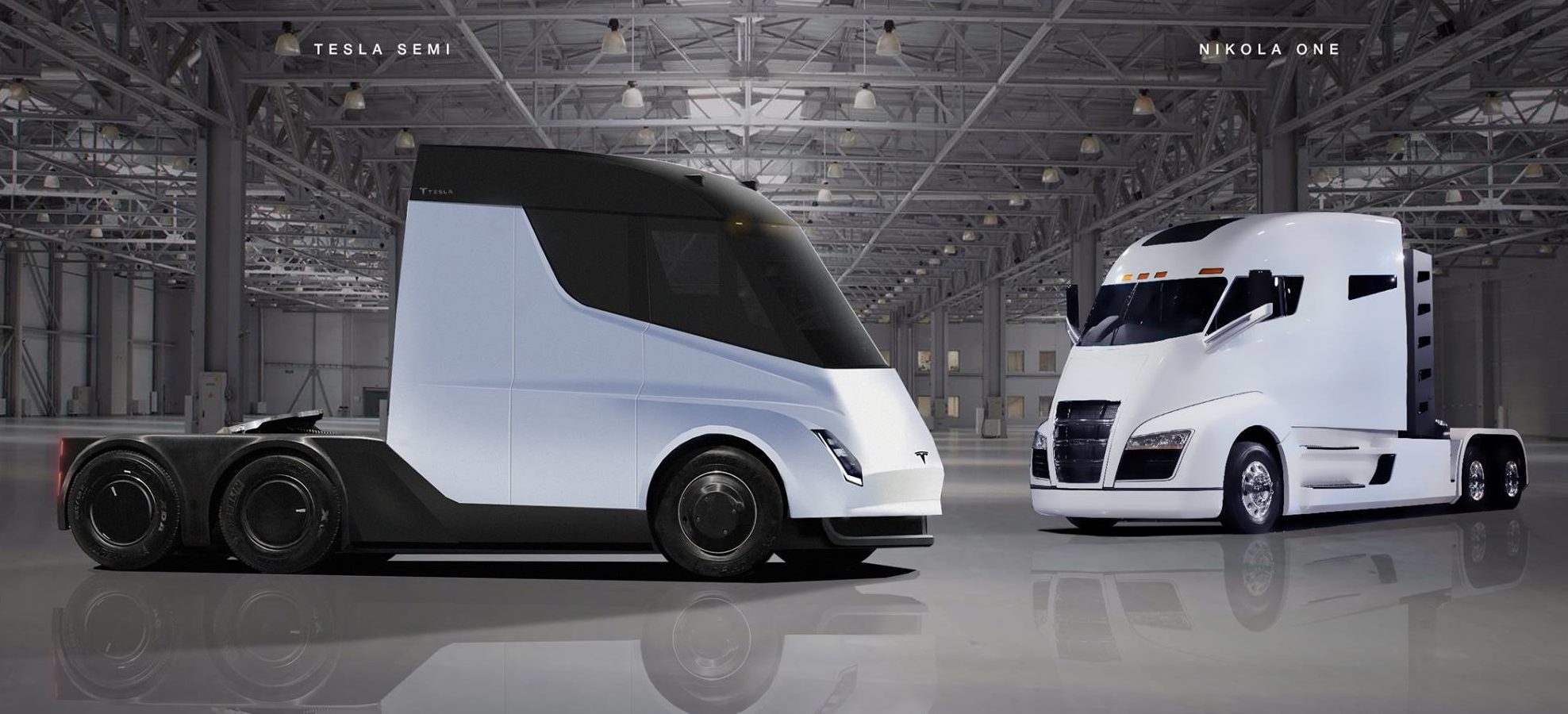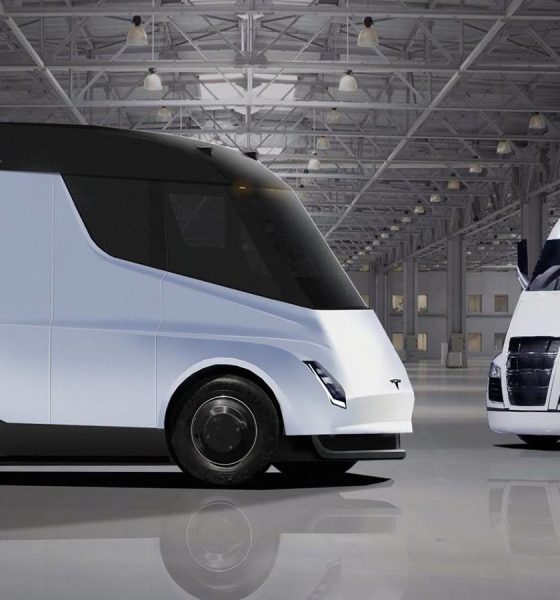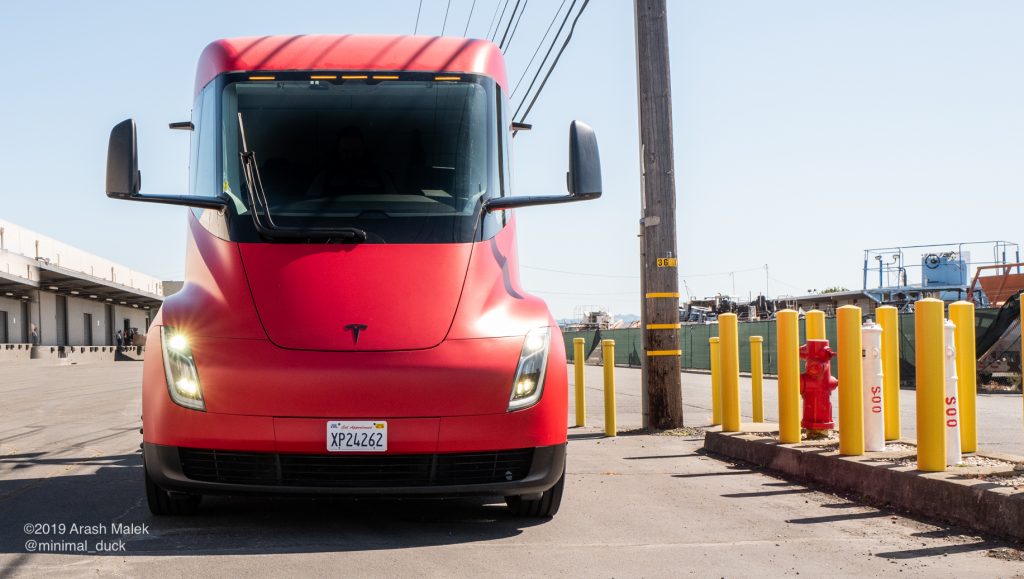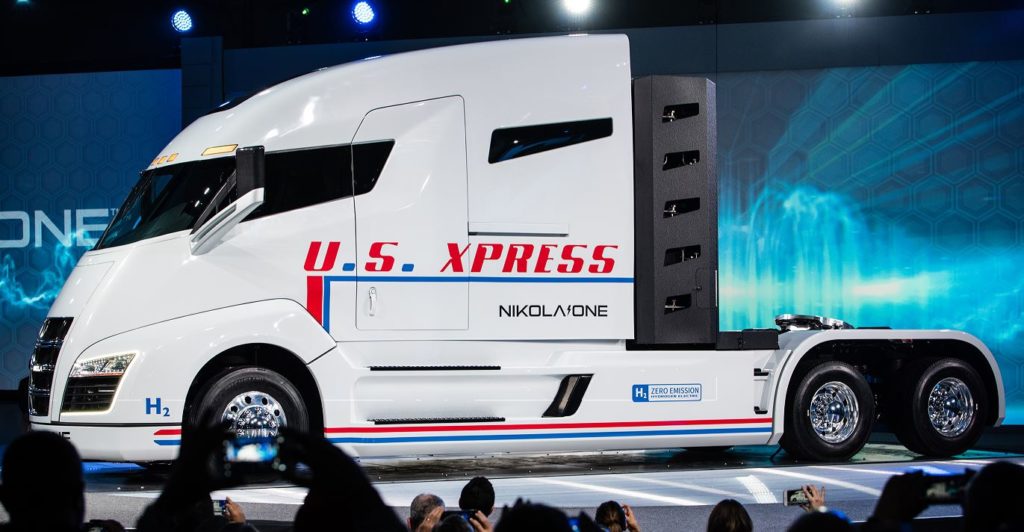

News
Tesla Semi lawsuit drags on with small victory for Nikola Motor
Almost two years ago, Nikola Motors surprised the trucking market by filing a $2 billion lawsuit alleging that the Tesla Semi copied several design elements from the Nikola One, the truck-maker’s flagship hydrogen long hauler. News about the patent lawsuit has been scarce for over a year, but recent updates indicate that Nikola has snatched a small victory from the Silicon Valley-based electric car maker.
Nikola’s case listed several characteristics of the One that were allegedly copied by Tesla. These included the Semi’s wraparound windshield, mid-entry door, front fenders, and the all-electric truck’s aerodynamic shape. To highlight its point, Nikola stated that the similar drag coefficients between the One (0.37) and the Semi (0.36) was further proof that the battery electric long hauler was copied from the hydrogen fuel-cell sleeper cab.
Excerpts from Nikola’s lawsuit pointed out that the Semi’s design had caused confusion among the One’s customers, diverting sales from the hydrogen truck maker to Tesla. Nikola also argued that these confusions might result in the Semi’s problems being attributed to the One, such as those resulting from Tesla’s batteries and Autopilot software. These, according to Nikola, are causing damage to its brand.

“Tesla has had problems with its batteries starting fires and its autonomous features causing fatal accidents. Should these problems arise with the Tesla Semi, the market will attribute these problems to Nikola because of the similarities between the two vehicles. Customers will also impute the Tesla Semi’s limitations (distance and charging time) to Nikola, which will make Nikola’s product less appealing to customers,” the hydrogen truck maker noted in its complaint.
Unfortunately for Nikola, cases that are centered on design patents are very difficult to prove. This point was especially highlighted in August 2018 when the US Patent Office awarded Tesla a pair of design patents for the Semi that actually listed the Nikola One as a reference, which meant that the examiner deemed Tesla’s design as unique. For Nikola to win its case against Tesla, it would have to prove that the US Patent Examiner made a mistake when comparing the Semi and the One’s designs, and that’s a very difficult point to argue.

Yet if recent tweets from Nikola CEO Trevor Milton are any indication, it appears that the hydrogen truck maker has stood by its lawsuit against Tesla. As it turned out, Tesla had filed a request with the Patent Trial and Appeal Board in September 2019 asking for a review to invalidate Nikola’s side door patent for the One. This request seems to have failed. Granted, it is a very small victory for Nikola, considering that it is fighting an incredibly steep uphill battle. Still, the dismissal of Tesla’s effort is a victory for the hydrogen truck maker nonetheless.
“Tesla loses bid to invalidate @nikolamotor patents in USPTO dispute. USPTO not only upheld Nikola semi truck important patents but refused Tesla’s ask to modify our patents. Two billion-dollar lawsuit moving forward. We will defend our company’s IP no matter who it is,” Milton wrote on Twitter.
In a statement to Forbes, Nikola Chief Legal Officer Britton Worthen lauded the decision, stating that the development was “obviously favorable” and that the company believes the matter was “decided correctly.” Tesla, for its part, has declined to comment. That being said, a Tesla spokesperson has noted in the past that “It’s patently obvious there is no merit to this lawsuit.” Elon Musk does not seem to be bothered by the suit either, noting in a previous earnings call that the entire situation is a case of fate loving irony.
Ultimately, the Nikola One may very well be beaten to the market by the Tesla Semi. While the One was unveiled prior to Tesla’s all-electric truck, prototypes of the Semi have been conducting real-world testing since the vehicles were unveiled. Recent sightings of the all-electric trucks suggest that the vehicles are now being tested in harsh conditions. This hints that Tesla may actually be on track to start early production runs of the Semi sometime later this year, as hinted at by the company in the past. Nikola, for its part, seems to be on track to release the Nikola Two, a shorter-range, battery electric truck, before the One. The company expects to start production of its trucks next year.

Elon Musk
Elon Musk and Tesla AI Director share insights after empty driver seat Robotaxi rides
The executives’ unoccupied tests hint at the rapid progress of Tesla’s unsupervised Robotaxi efforts.

Tesla CEO Elon Musk and AI Director Ashok Elluswamy celebrated Christmas Eve by sharing personal experiences with Robotaxi vehicles that had no safety monitor or occupant in the driver’s seat. Musk described the system’s “perfect driving” around Austin, while Elluswamy posted video from the back seat, calling it “an amazing experience.”
The executives’ unoccupied tests hint at the rapid progress of Tesla’s unsupervised Robotaxi efforts.
Elon and Ashok’s firsthand Robotaxi insights
Prior to Musk and the Tesla AI Director’s posts, sightings of unmanned Teslas navigating public roads were widely shared on social media. One such vehicle was spotted in Austin, Texas, which Elon Musk acknowleged by stating that “Testing is underway with no occupants in the car.”
Based on his Christmas Eve post, Musk seemed to have tested an unmanned Tesla himself. “A Tesla with no safety monitor in the car and me sitting in the passenger seat took me all around Austin on Sunday with perfect driving,” Musk wrote in his post.
Elluswamy responded with a 2-minute video showing himself in the rear of an unmanned Tesla. The video featured the vehicle’s empty front seats, as well as its smooth handling through real-world traffic. He captioned his video with the words, “It’s an amazing experience!”
Towards Unsupervised operations
During an xAI Hackathon earlier this month, Elon Musk mentioned that Tesla owed be removing Safety Monitors from its Robotaxis in Austin in just three weeks. “Unsupervised is pretty much solved at this point. So there will be Tesla Robotaxis operating in Austin with no one in them. Not even anyone in the passenger seat in about three weeks,” he said. Musk echoed similar estimates at the 2025 Annual Shareholder Meeting and the Q3 2025 earnings call.
Considering the insights that were posted Musk and Elluswamy, it does appear that Tesla is working hard towards operating its Robotaxis with no safety monitors. This is quite impressive considering that the service was launched just earlier this year.
Elon Musk
Starlink passes 9 million active customers just weeks after hitting 8 million
The milestone highlights the accelerating growth of Starlink, which has now been adding over 20,000 new users per day.

SpaceX’s Starlink satellite internet service has continued its rapid global expansion, surpassing 9 million active customers just weeks after crossing the 8 million mark.
The milestone highlights the accelerating growth of Starlink, which has now been adding over 20,000 new users per day.
9 million customers
In a post on X, SpaceX stated that Starlink now serves over 9 million active users across 155 countries, territories, and markets. The company reached 8 million customers in early November, meaning it added roughly 1 million subscribers in under seven weeks, or about 21,275 new users on average per day.
“Starlink is connecting more than 9M active customers with high-speed internet across 155 countries, territories, and many other markets,” Starlink wrote in a post on its official X account. SpaceX President Gwynne Shotwell also celebrated the milestone on X. “A huge thank you to all of our customers and congrats to the Starlink team for such an incredible product,” she wrote.
That growth rate reflects both rising demand for broadband in underserved regions and Starlink’s expanding satellite constellation, which now includes more than 9,000 low-Earth-orbit satellites designed to deliver high-speed, low-latency internet worldwide.
Starlink’s momentum
Starlink’s momentum has been building up. SpaceX reported 4.6 million Starlink customers in December 2024, followed by 7 million by August 2025, and 8 million customers in November. Independent data also suggests Starlink usage is rising sharply, with Cloudflare reporting that global web traffic from Starlink users more than doubled in 2025, as noted in an Insider report.
Starlink’s momentum is increasingly tied to SpaceX’s broader financial outlook. Elon Musk has said the satellite network is “by far” the company’s largest revenue driver, and reports suggest SpaceX may be positioning itself for an initial public offering as soon as next year, with valuations estimated as high as $1.5 trillion. Musk has also suggested in the past that Starlink could have its own IPO in the future.
News
NVIDIA Director of Robotics: Tesla FSD v14 is the first AI to pass the “Physical Turing Test”
After testing FSD v14, Fan stated that his experience with FSD felt magical at first, but it soon started to feel like a routine.

NVIDIA Director of Robotics Jim Fan has praised Tesla’s Full Self-Driving (Supervised) v14 as the first AI to pass what he described as a “Physical Turing Test.”
After testing FSD v14, Fan stated that his experience with FSD felt magical at first, but it soon started to feel like a routine. And just like smartphones today, removing it now would “actively hurt.”
Jim Fan’s hands-on FSD v14 impressions
Fan, a leading researcher in embodied AI who is currently solving Physical AI at NVIDIA and spearheading the company’s Project GR00T initiative, noted that he actually was late to the Tesla game. He was, however, one of the first to try out FSD v14.
“I was very late to own a Tesla but among the earliest to try out FSD v14. It’s perhaps the first time I experience an AI that passes the Physical Turing Test: after a long day at work, you press a button, lay back, and couldn’t tell if a neural net or a human drove you home,” Fan wrote in a post on X.
Fan added: “Despite knowing exactly how robot learning works, I still find it magical watching the steering wheel turn by itself. First it feels surreal, next it becomes routine. Then, like the smartphone, taking it away actively hurts. This is how humanity gets rewired and glued to god-like technologies.”
The Physical Turing Test
The original Turing Test was conceived by Alan Turing in 1950, and it was aimed at determining if a machine could exhibit behavior that is equivalent to or indistinguishable from a human. By focusing on text-based conversations, the original Turing Test set a high bar for natural language processing and machine learning.
This test has been passed by today’s large language models. However, the capability to converse in a humanlike manner is a completely different challenge from performing real-world problem-solving or physical interactions. Thus, Fan introduced the Physical Turing Test, which challenges AI systems to demonstrate intelligence through physical actions.
Based on Fan’s comments, Tesla has demonstrated these intelligent physical actions with FSD v14. Elon Musk agreed with the NVIDIA executive, stating in a post on X that with FSD v14, “you can sense the sentience maturing.” Musk also praised Tesla AI, calling it the best “real-world AI” today.








